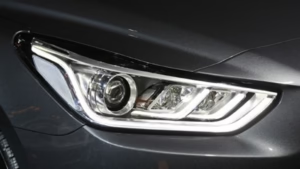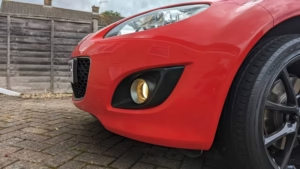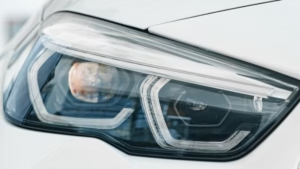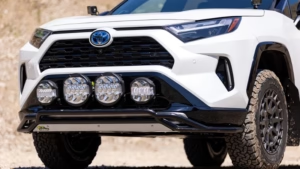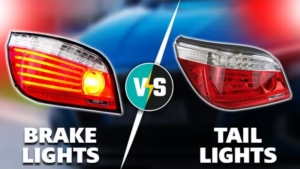Car bumpers play an essential role in vehicle safety and aesthetics. Whether it’s a plastic bumper or a sturdy tube bumper, auto bumpers vary widely in design, construction, and functionality. In this article, we will explore the guide to car bumpers.
What is a Car Bumper?
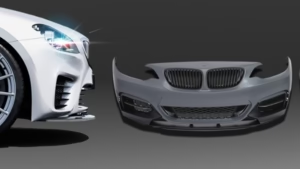
A car bumper is the protective component affixed to the front and back ends of a vehicle engineered to absorb impact and protect a vehicle’s front and rear during collisions. The car front bumper sits below the headlights, shielding the engine and grille, while the car back bumper resides beneath the taillights, safeguarding the trunk and rear components. These bumpers absorb and dissipate impact forces during minor collisions or accidents, protecting not only the vehicle itself but also its occupants and pedestrians.
Functions of a Car Bumper
The auto bumper serves multiple critical roles, blending safety, functionality, and style. Its diverse functions make it indispensable in automotive design:
- Impact Absorption: The car bumper absorbs and disperses energy during low-speed collisions, minimizing damage to the vehicle and its occupants.
- Vehicle Protection: The bumper shields critical parts located at the car front or rear, including headlights, radiators, and exhaust pipes.
- Pedestrian Safety: Designed with softer materials and rounded edges, bumpers reduce injury severity in pedestrian accidents.
- Aesthetic Integration: The plastic bumper, often painted to match the vehicle’s body, enhances visual appeal, seamlessly blending with the car’s contours.
- Aerodynamic Improvement: A well-designed bumper reduces air resistance, optimizing airflow to boost fuel efficiency and performance.
Components of a Car Bumper
The modern auto bumper system comprises several integral parts working together to ensure optimal performance and durability:
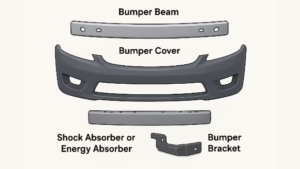
Bumper Beam
The main structural element that bears the impact force. It is usually made from metal such as steel or aluminum to provide strength and rigidity.
Bumper Cover
The external shell, often made of plastic, that shapes the visible part of the bumper for appearance and minor impact cushioning.
Shock Absorber or Energy Absorber
Positioned between the cover and beam, typically made of foam or plastic materials, this component absorbs and dissipates impact energy to reduce force transmission to the vehicle frame.
Bumper Bracket
These brackets securely attach the bumper assembly to the vehicle’s chassis, ensuring proper alignment and stability.
For precise shaping of these parts, Zhongren provides high-quality custom plastic molding services, enabling accurate fit, consistent strength, and smooth surface finishes.
Custom Plastic Molding Solutions
Types of Car Bumpers
Various automobile designs call for different types of bumpers, each tailored for specific vehicle needs and purposes. Below are the most common types of car bumpers:
Standard Bumper
The standard bumper is the most widely used type of car bumper. It integrates seamlessly with the vehicle’s body, covering the entire front or rear of the car. Made predominantly from lightweight plastics such as polycarbonate or fiberglass, these bumpers offer balanced protection and visual appeal. They are relatively cost-effective and easy to replace when damaged, making them a popular choice for everyday passenger vehicles.
Step Bumper
Commonly seen on pickup trucks and SUVs, the step bumper features a built-in step within its design. This addition facilitates easier access to the truck bed or roof. Typically constructed from durable metals like steel or aluminum, step bumpers combine robust protection with functional convenience.
Tube Bumper
The tube bumper employs hollow metal tubes, usually aluminum or steel, forming a rugged protective structure. It is favored for off-road vehicles given its ability to withstand rough terrains, shielding the car from rocks, tree branches, and other harsh obstacles encountered outdoors.
Cowboy Bumper
Also known as a deep drop bumper, the cowboy bumper is mostly fitted on heavy-duty trucks. It has a distinct design with a drop-down center section that extends lower than regular bumpers, offering extra protection beneath the vehicle. Crafted mainly from steel or reinforced plastic, cowboy bumpers excel in durability and towing support.
Roll Pan Bumper
Designed for a sleek and customizable look, the roll pan bumper blends smoothly with the vehicle’s lower body. It emphasizes aesthetics and aerodynamic performance over heavy-duty protection. This type is popular among car enthusiasts who prefer stylish, streamlined vehicles but is less effective in off-road or impact-heavy uses.
Materials Used in Car Bumpers
Selecting the right car bumper material for a bumper depends heavily on factors like durability, weight, cost, and appearance. For custom auto bumper solutions, these considerations ensure the bumper performs well under real-world conditions while complementing the car’s look.
- Polycarbonate (PC): Known for high impact resistance and flexibility, PC is lightweight and can withstand minor collisions without cracking. It is widely used in bumper covers for both front and back bumpers, offering excellent durability and the ability to be molded into complex shapes.
- Acrylonitrile Butadiene Styrene (ABS): ABS provides a good balance between rigidity and impact resistance, staying tough even in low temperatures. ABS bumpers are easy to paint and can achieve a glossy finish, making them ideal for visible plastic bumper covers.
- Polypropylene (PP): Commonly regarded as the most cost-effective choice, PP bumpers are lightweight and easily modifiable with additives for enhanced performance, such as improved impact resistance and weather durability. Foam inserts used in bumper absorbers often consist of modified polypropylene.
- Steel and Aluminum: These metals serve primarily in structural bumper components like the bumper beam and brackets. Aluminum is particularly valued for being strong yet lighter than steel, making it suitable for premium vehicle models aiming to save weight without compromising strength.
- Carbon Fiber: Emerging as a high-end material, carbon fiber is exceedingly strong and lightweight, used in sports or luxury vehicles’ bumpers where performance and aesthetics are paramount. However, its high cost limits its application.
Zhongren for Car Bumper Customization
A well-designed car bumper is indispensable for vehicle safety, functionality, and appearance. Selecting the proper materials and bumper types is key to ensuring longevity and effective vehicle protection. Zhongren supplys various types and materials selection for car bumper customization as a trusted custom plastic manufacturer. Welcome to consult Zhongren for auto bumper custom solutions.
FAQs
Are car bumpers easily damaged?
Car bumpers are designed to absorb low-speed impacts without significant damage. However, plastic bumpers may crack or dent in higher-speed collisions, while metal bumpers are more durable but prone to scratches or corrosion.
What is the manufacturing process of plastic bumpers?
Plastic bumpers are typically made by injection molding thermoplastic materials like polypropylene (PP), ABS, or polycarbonate (PC). And then painting or finishing it for aesthetic appeal.
Are your bumpers compatible with all types of lighting?
Yes, Zhongren’s bumpers are custom-designed with advanced 3D modeling and precise tooling to fit various lighting types including headlights, fog lights, LED bars and sensor lights. We work closely with lighting manufacturers to ensure perfect compatibility for your vehicle.
